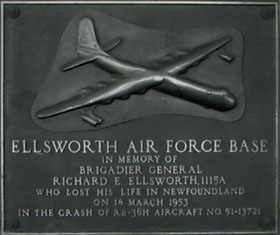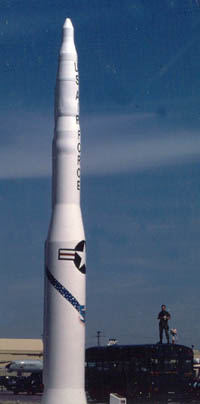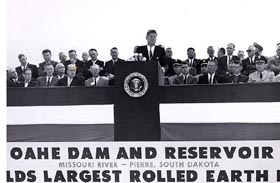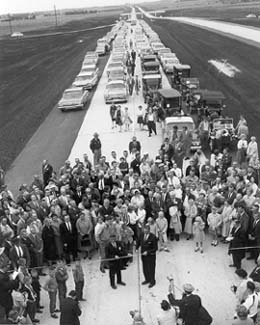Lesson
3
People on the Move
|
|
|
|
The two atomic bombs that ended the
Second World War were the start of the Cold War. Many countries
rushed to build more atomic bombs. The United States stored hundreds
underground in western South Dakota. Ellsworth Air Force Base
in Rapid City became part of a special unit. It was called the
Strategic Air Command (SAC). This unit could take off in planes
armed with atomic bombs. They could fly anywhere in only a few
hours.
|

Photo courtesy of South Dakota State
Historical Society
|
|
|
Soon
tension
built up between two countries that had many bombs. These were the
United States and the Soviet Union. They had different forms of
government. The United States is a democracy. Citizens give power to
the government (you read about this in Unit 8). The Soviet Union was
Communist. Its government told its citizens what to do. It took
charge of all property and money. The struggle between these two
governments was called the Cold War. People worried that it would
become a hot war. This would
unleash
the atomic bombs. The thought troubled people around the world.
|
|
|
|

Photo courtesy of South Dakota
Department of Tourism
|
Then in 1950, the Cold War heated up.
North Korea invaded South Korea. The Soviet Union backed North
Korea. The United States rushed to aid South Korea. So did other United
Nations countries. Thousands of people from South Dakota served
in the war. Even though a
truce
ended the fighting, the Cold War did not end. More planes, bombs,
and atomic missiles were stored in western South Dakota.
|
|
|
|

Photo courtesy of South Dakota State
Historical Society
|
|
|
|
While war raged in Korea, construction
crews were working on the dams on the Missouri River (you read about
this in Unit 7). Their work would change the riverís flow and the
land itself. Flood control was an important reason for this work. No
longer would there be yearly floods in towns like Pierre and
Yankton. Some small towns had to move before the lakes began to form
behind the dams. Pollock moved a mile south of where it had
been. Then lake waters flooded farmlands and Indian sites on the
river bottom. Some things were lost, but "Old Miseryís" water was no
longer muddy. Instead, the new lakes were clear blue. President John
F. Kennedy came to open the Oahe Dam. The year was 1962.
|
|

Photo courtesy of South Dakota State
Historical Society
|
Times were good in South Dakota. Despite
droughts and low prices for farm products, ranching and farming
thrived. By 1960, most farmers had electricity. They used tractors,
combines, and corn pickers. These things made their work easier.
Farmers
experimented with new
crops. They grew soybeans and sunflowers. Tourism also thrived. More
South Dakota highways were blacktop rather than gravel. It was
easier for tourists and families to drive to the Corn Palace, the Badlands, or
Mount Rushmore.
|
|
|
|
South Dakota farms and ranches kept
growing. The
average
one grew
from 672 acres to 804 acres. The number of jobs for farm workers
dropped, though. Machines now did much of the work. People from
small towns moved to bigger towns, looking for jobs. Others moved to
big cities outside the state. Finding work on Indian reservations
was even harder.
The towns of Sioux Falls, Rapid City,
and Aberdeen grew. The population of the state fell. By 1970, tens
of thousands of people left South Dakota. Nearly two hundred small
towns died. Farmers and ranchers no longer needed a railroad town
nearby. They could drive fifty miles to a bigger town and be back in
no time. Their children rode school buses to
consolidated schools.
|
|
|
|
|
Miles of railroad track were no
longer used. In its place were better roads. New interstate highways
made travel fast and safe. These highways had four lanes. I-29 ran
north and south; I-90 went east and west. They linked South Dakota
to other parts of the country. Many South Dakotans also took to the
air. They got on commercial planes at airports in the larger towns.
South Dakotans did not really need to leave their living rooms to see
the world. A new invention was bringing the world to South Dakota.
That invention was television.
|

Photo courtesy of South Dakota State
Historical Society
|
|
|
|
| Vocabulary |
|
| average (adj.),
a typical size or amount; ordinary
consolidated (adj.), united; combined; brought together
experimented (v.), tried; tested
|
tension (n.), an uneasy feeling; a worry or concern
truce (n.), an agreement to stop fighting
unleash (v.), to release something
|
|
|